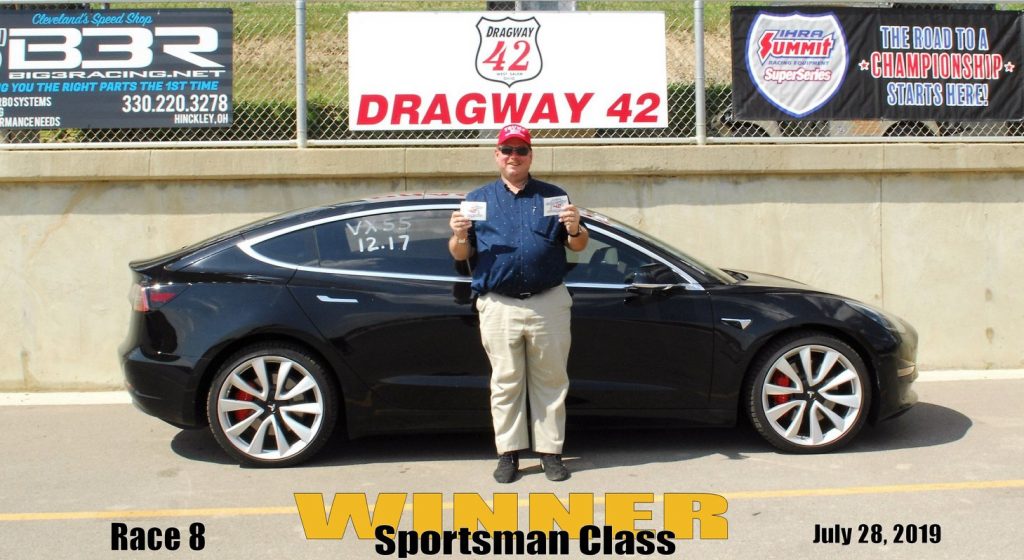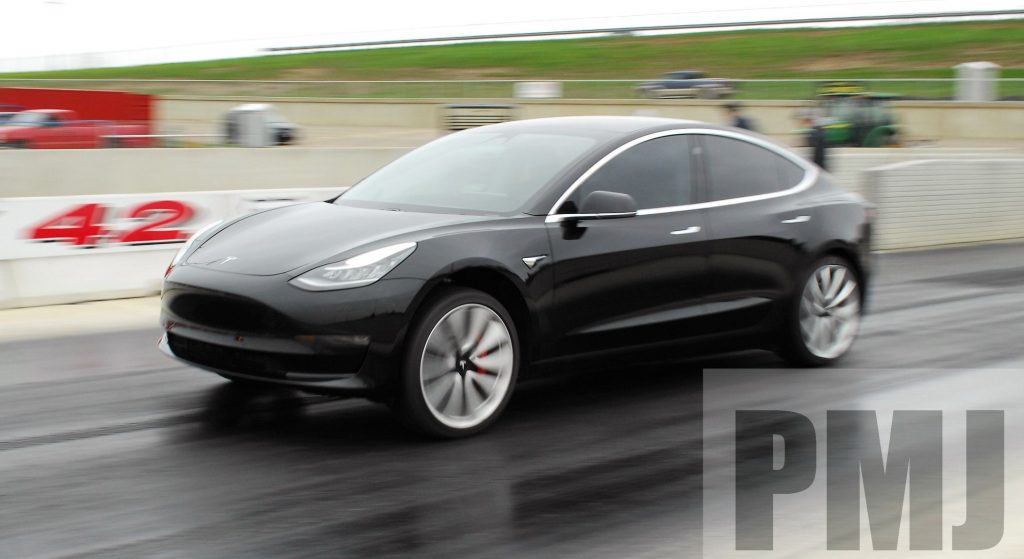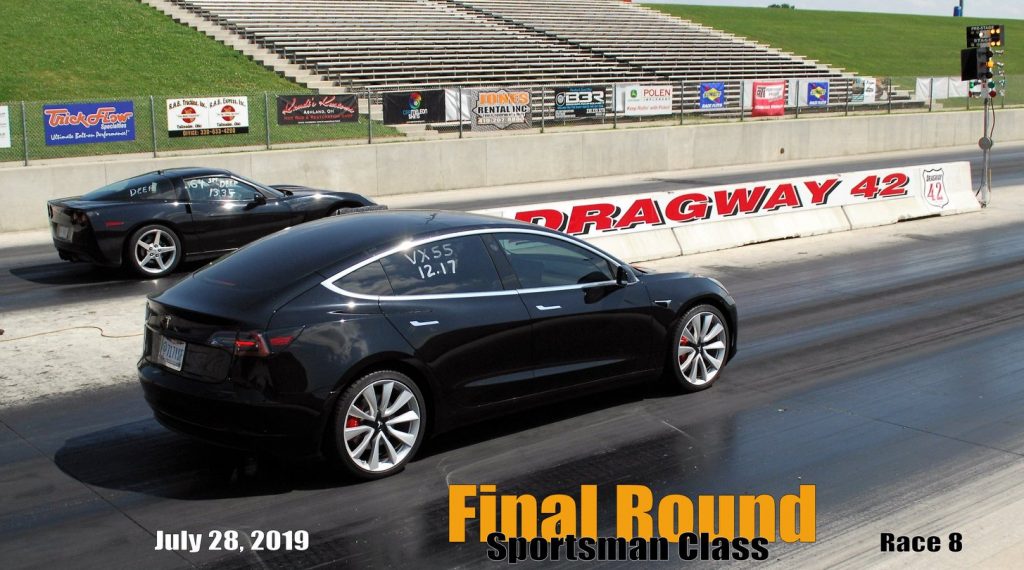
It’s been three decades and then some since Wayne Darlington claimed his first points championship, winning the Street Class at Amarillo Dragway in 1984. It remained his only championship for many years, but that changed with his recent finish as the 2019 IHRA Summit SuperSeries points leader in the Sportsman Class at Dragway 42 in West Salem, OH.
New to the Summit SuperSeries in 2019, the Sportsman Class replaces the popular Street Class and affords drivers of electric vehicles an opportunity to compete in the popular bracket racing series.
Along with his victory at Dragway 42, Darlington—who competed throughout the season in a Tesla Model 3—has earned a shot at become the first-ever Sportsman National Champion at the SuperSeries World Finals, taking place Oct. 17-19 at Memphis International Raceway. Coincidentally, a victory at the national event also would make him the first to do it in an electric car.
The significance of his first points championship in 35 years isn’t lost on Darlington, who told OnAllCylinders that he appreciates his latest victory “so much more than the first.”
“It took me eight years to win the first championship, so I knew they weren’t easy to come by,” he said. “I missed out on another one about a dozen years ago, when I ran over some debris and flattened a tire on my final time trial at the last points race. The second-place car in points went on to win that event and to take that championship by a single point.”
Consistency is critical in bracket racing, and Darlington is realistic about his chances heading into October’s World Finals event at track hundreds of miles from his home—and one at which he’s never participated.
“There is no “easy win” at an event like this,” he said. “The race itself will be made up of only track champions from around the country and the class winners from the seven regional Summit Team finals that will be conducted around the country…. You have to bring your A-game and a couple four-leaf clovers.”
A Family that Speeds Together
Darlington is a second-generation racer whose parents both spent time drag racing in the early 1960s at the Kansas City Timing Association’s drag strip. He competed in his first drag competition the weekend after his 16th birthday, racing a 1964 Chevy Impala Super Sport at Tulsa International Raceway.
Within a year, Darlington had moved onto a dedicated racecar: a 1962 Impala Super Sport with a class-legal 409 Super Stock engine. Numerous other vehicles have made their way in and out of his arsenal over the years.
“In addition to door cars, trucks, and a big station wagon that have had ETs ranging from the 12s to the 19s, I’ve also run an altered, a front engine dragster, and a pair of rear engine dragsters—one of which is sitting in the trailer since I was given a ‘loaner car’ to race this season,” he said.

The Tesla “loaner car” was provided by his son Petty Officer 1st Class Bryan Darlington, who is serving in the U.S. Navy aboard the U.S.S. Abraham Lincoln. Bryan shares his father’s love for racing, noting that some of his earliest childhood memories are from events at Amarillo Dragway. After several cross-country moves during his childhood put racing on hold, his family eventually settled in Akron, OH.
“Once it was apparent that Akron appeared to be our home for the foreseeable future, we got back into [racing] as a family,” Bryan Darlington said. “…In 2002, once I turned 16, I began driving our tow vehicle in the Street Class and raced for four years until I joined the Navy.”
Going Electric
Bryan Darlington’s own passion for drag racing played a role in his decision to buy the Tesla that eventually carried his father to the Dragway 42 Sportsman Class championship.
“The performance numbers that I had read about was one of the reasons I pulled the trigger on buying,” he said. “But a lot of it came down to wanting the performance but not the cost in gas of a 40-mile daily round trip while driving an LS3. ‘What will it do on the dragstrip?’ is always a question on my mind when I look at a car, but it’s rarely the first one.”
Right off the showroom floor, the car was a second faster in the quarter-mile than his previous LS3-powered 2015 Chevy SS, he said.

When Bryan got notice that would be deployed again last April, he asked his father to store the vehicle instead of leaving it at the base. He allowed him to race it, too—not that he had much of a choice.
“I said, ‘Sure—but you know if I’m going to store it, I’m also going to race it,’” Wayne Darlington told OnAllCylinders. “He said, ‘Sure—as long as you split the prize money with me.’ I said, ‘Deal.’”
The performance capability of the Tesla Model 3 became immediately apparent to Darlington.
“The Tesla certainly launches harder than any street-legal machine I’ve ever driven, though not as hard as my altered or dragsters,” he said. “The Tesla is far more stable at 110+ mph than any race car I’ve driven.”
However, racing in the Tesla hasn’t been all sunshine and roses. According to Darlington, the vehicle poses some “unique challenges.”
“First, the car burns off 5-10 miles of range every pass,” he said. “Putting the car on a 110v charger will only add about half of that amount back to the battery in an hour, and it’s not unusual for us to make a run every 15 minutes in the later rounds of eliminations.
“Due to the battery power level drop, the Tesla loses about 2/10th of a second of ET over the course of a race day and nearly a half second over a multi-day weekend race, which is a challenge when participating in bracket racing,” he continued. “In addition, I have to adjust where I leave on the Christmas tree over the course of an event because the car doesn’t leave as hard from one run to the next as the battery power drops.”
Darlington pointed to another staging-related challenge. In most “footbrake” racing vehicles, a driver combines using the brake and gas pedals to launch the vehicle at a certain rpm. Using the same approach is more difficult in the Tesla, he said.
“In the Tesla, the vehicle becomes confused if both the brake and throttle pedals are depressed at the same time,” Darlington said. “That means I have to stage the car with as little brake as possible while holding my right foot over—but not touching—the throttle pedal until I’m ready to react to that last amber of the Christmas tree to start the race.”
Darlington is looking forward to his opportunity to race in the World Finals in a few months and add a new trophy and championship ring to the Amarillo Dragway Street Track Champion jacket that still hangs in his closet. But in spite of his success during a racing season spent in his son’s Tesla, Darlington isn’t quite ready to buy an electric car for himself.
“It has been an honor and a pleasure to occasionally drive and race Bryan’s Tesla, but the initial financial expense and somewhat limited driving range of an electric car still don’t make sense for myself as a daily driver,” he said. “And my wife says that we already have way too many cars in our ‘fleet.’”

Comments